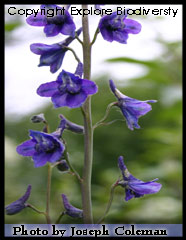

 Delphinium:
Delphinium sp
Delphinium:
Delphinium sp
Other names: Larkspur
As a garden plant, who can contend with the showy inflorescences of the Delphinium. In the wild their most commonly called larkspurs. These wild species are equally beautiful, although their flowers are substantially smaller. Like monkshood, this plant is highly toxic. The work Delphinium is Greek (dolphin), meaning dolphin. Apparently the nectaries of these plants (of which there are nearly 300 species), look like imaginary dolphins. Its important to realize how toxic these plants are though. A few ounces can kill a human.
Medicinal Uses: Because of the high toxicity of this plant, there are no effective internal uses of this plant that can be taken without medical supervision. By prescription only, it has been used to sedate the nerves and heart and to reduce fevers. A good use of the plant, however, is to apply it externally as a shampoo to kill lice. This practice has been used for centuries.
Food use: Don’t even think about eating this plant.
Even a small taste that is quickly spit out, can cause poisoning. It’s
been said that three grains of the root (the size of a rice grain), can
kill a hefty adult. Usually death occurs in about 6 hours. In fact, the
plant has been used for centuries to tip the end of arrows when going
into battle.